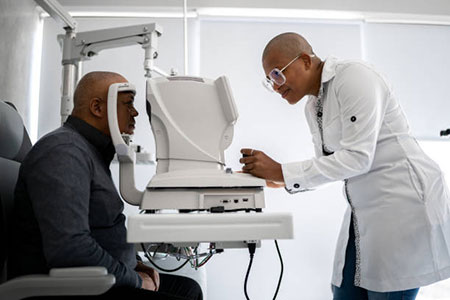Study sheds light on how to increase diabetic eye exams
Transportation, cost and insurance questions, difficulty scheduling an appointment and fear are the primary reasons Black patients with diabetes are not getting vision-saving annual eye exams.
People with diabetes are at risk for vision loss and blindness from a disease called diabetic retinopathy (DR). It’s a condition that affects blood vessels in the retina, which is the light-sensitive layer of tissue in the back of the eye. A comprehensive, dilated eye exam at least once a year can help patients take steps to protect their vision.
 According to the Centers for Disease Control and Prevention’s Vision and Eye Health Surveillance System:
According to the Centers for Disease Control and Prevention’s Vision and Eye Health Surveillance System:
- In 2021, 9.6 million people in the United States had DR, and of these, 1.84 million had vision-threatening DR.
- Prevalence is highest among people aged 65-79 years and higher among men than women.
- DR is also more prevalent in Black, American Indian/Alaska Native, and Hispanic/Latinx people.
- Black adults with diabetes are 1.5 to 2.5 times more likely than White adults to have diabetic retinopathy, lower limb amputation, and stroke.
- DR screening rates are especially low in people with low income and who are historically marginalized, and in people with an increased risk of developing diabetes and higher prevalence and severity of DR.
“We know that Black men in particular do not manage their diabetes as well as we would like,” notes Denise White-Perkins, MD, PhD, Henry Ford Health’s Family Medicine Department Chair and Director of Healthcare Equity Initiatives. “We also knew there likely were a range of reasons why the rate of diabetic eye exams is so low among Black men. As a result of our research we now have a much better idea of how to help this population get the care they need.”
Premier, Inc.’s PINC AI Applied Sciences (PAS) contracted with Henry Ford Innovations (HFI) and Genentech to conduct the 18-month research study, which was led by Dr. Perkins. Henry Ford’s Patient Engaged Research Center (PERC) also played a key role.
Involving the community and physicians
The research team partnered with the Detroit Association of Black Organizations and New Calvary Baptist Church in Detroit so that they could connect directly with patients experiencing inequities in diabetic eye screening. Then, the idea was to adapt and test tools and educational materials to support Black adults with the goal of increasing awareness and actual scheduling of exams.
PERC designed and facilitated focus group and interview sessions with community members and physicians, developed guiding materials, and carried out preliminary analysis of the data. This early analysis allowed the team to identify emerging themes and assess whether questions were effectively capturing the intended information.
Genentech provided existing educational materials such as posters, flyers and table tents. These were tested against alternate materials to see what resonated. For example, the blurred poster (at right) was much more impactful than the crisp, clear one by dramatically showing what it’s like to lose your vision.
Physicians were interviewed to understand workflows, barriers, and enablers for patients to receive the screening exams. They also were asked for feedback on materials and use of materials, including support tools for them to have crucial conversations about the exams with their patients.

What we learned from patients and physicians
- Finances and transportation: “No transportation” and “financial concerns” are the most common barriers to getting an exam. Both patients and providers report a lack of education around primary insurance vs. vision insurance and what is covered. Study advisers agree that a mobile eye clinic could help.
- Appointment scheduling: Patients expect an appointment backlog and considerable wait time to get an appointment. Providers acknowledged that the central scheduling system can be intimidating and confusing.
- Education: Both patients and providers expressed that the blurred baby image is more impactful than the clear image. People reported they were curious to know why the image was blurred and motivated by realizing the risk of blindness. Tent cards and posters were most likely to get people to use the QR code to access an appointment resource.
- Motivation: Community members reported being motivated by family history of illness/complications and family members encouraging them to seek care for diabetes, even when they have a fear of getting their eyes dilated. Male and female patient advisers report that men are more hesitant than women to seek care, miss work for appointments, and ask for help such as asking for a ride.
Action steps
Henry Ford is taking the information gained and recommending several improvements, including:
- Communication training for phone/registration staff
- Continued partnership with community/faith-based groups to outreach for awareness in combination with workflow to facilitate further testing or follow-up
- Increased use of navigators to help people overcome barriers to follow-up
- Physician/nurse training or messaging on communication tips to encourage patient responsibility
- Tip sheet, process improvement or workflow that will address insurance barriers.
HFI was proud to help address this serious and all too common health issue. The research team hopes to study the impact of education efforts on volume of appointments scheduled and appointments kept for the annual diabetic eye screening exam and make adjustments as needed.
.svg?iar=0&hash=F6049510E33E4E6D8196C26CCC0A64A4)
/hfh-logo-main--white.svg?iar=0&hash=ED491CBFADFB7670FAE94559C98D7798)